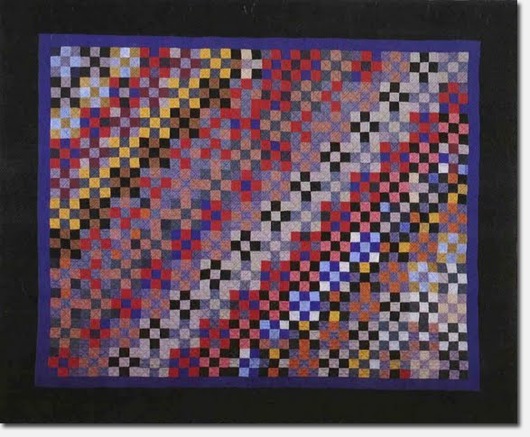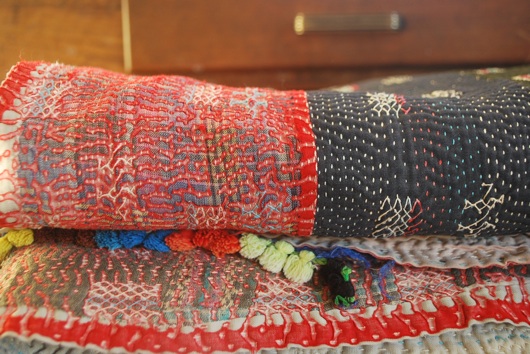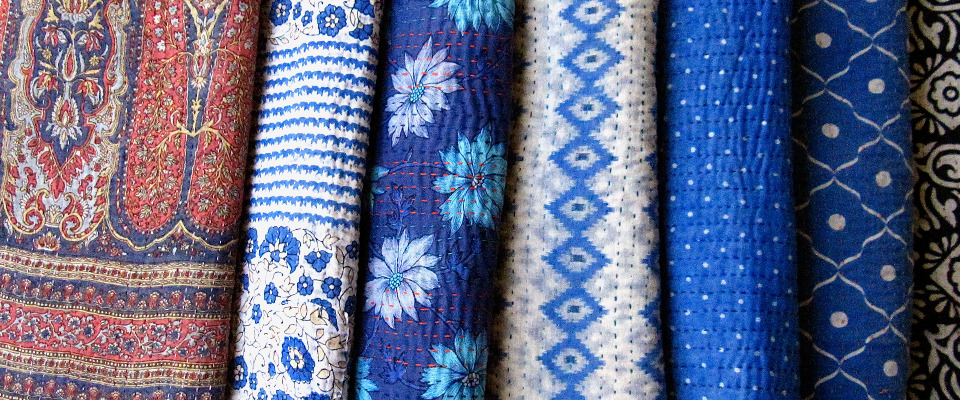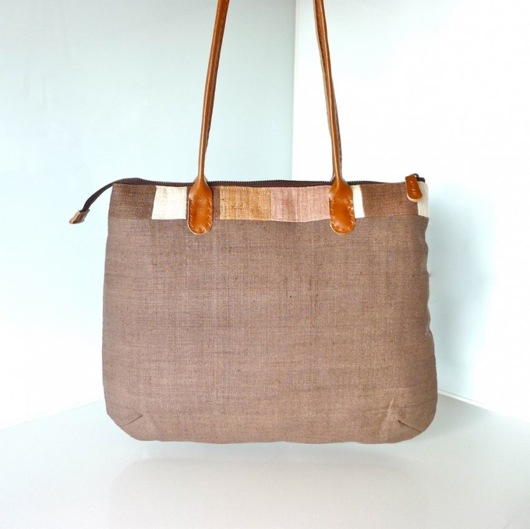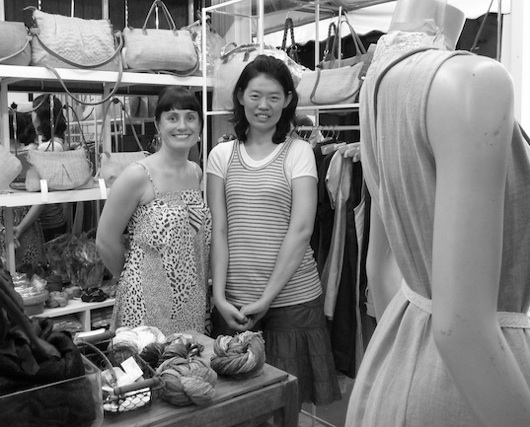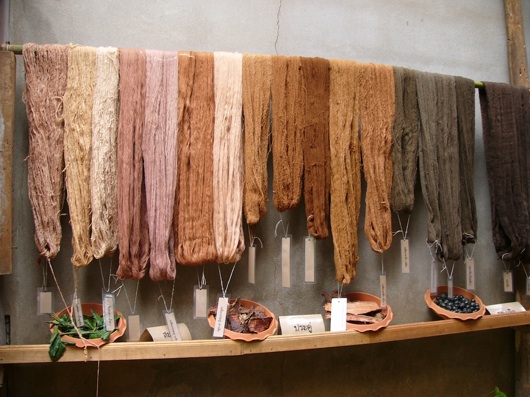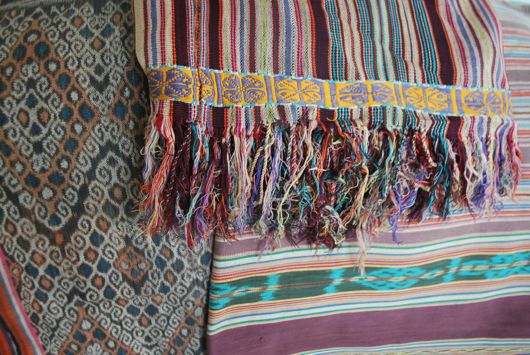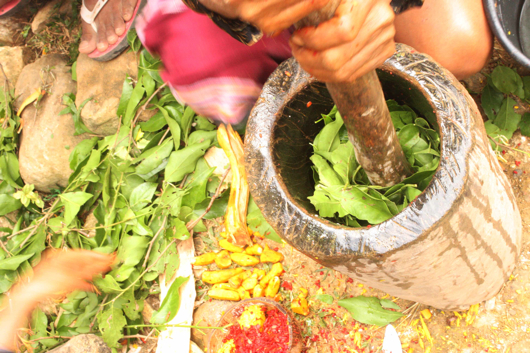Women in the World: Quilts, Part Two
By Joanna Francis This month, we continue to have a little squiz at some of the various quilts of the world and examine how they have evolved over time. I mentioned in the last post that one of the things that attracted me to quilting was their ability to tell a story and for a quilt to hold a person or a family’s history and pass it on from one generation to the next.
This quality is what has made quilting such a universal and popular art form and one which has become an inherent part of many communities. North America has a great tradition of quilting, some that you may be aware of such as the Amish quilts dating back from the 1870s and the Gee’s Bend quilts which continue to be made today.
Women from Amish communities used simple yet intricate and structured designs, making the most of offcuts of fabrics and meticulous hand stitching to create something useful as well as beautiful, in keeping with their community’s beliefs of hard work, tradition and self sufficiency. These quilts have become more intricate and bold as years have gone on and have become popular in other parts of the country and indeed the world.
In contrast the Gee’s Bend quilts, named after the town in Alabama in which they are made by African American women, use more improvised designs and simple geometrics and make use of old materials such as worn out clothes and cloth sacks.
 In both cases, what has become a decorative art began by simple necessity – keeping families warm in places where there was no electricity and few financial resources. In both cases also, the skills necessary to create the quilts were passed from mother to daughter and from one generation to the next and in this way are carried on today.
In both cases, what has become a decorative art began by simple necessity – keeping families warm in places where there was no electricity and few financial resources. In both cases also, the skills necessary to create the quilts were passed from mother to daughter and from one generation to the next and in this way are carried on today.
While the traditional styles of quilting, similar to the Amish quilts, continue alive and well today, the Gee’s Bend style of bold and modern innovation is certainly creating new interest in this old art form and is more inspiring to many, myself included. I love that ancient techniques and skills are being refreshed and brought to a new audience .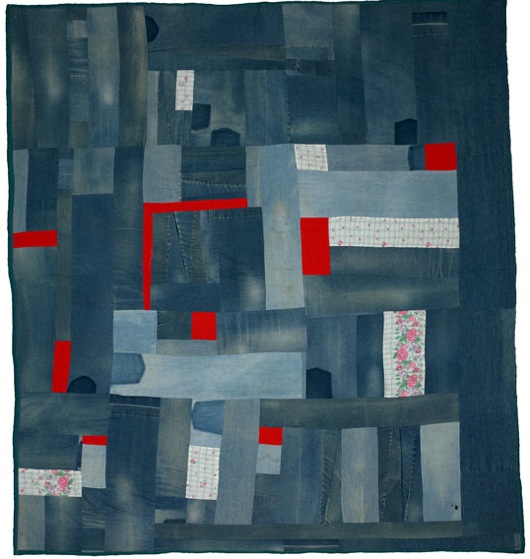
Moving back towards the east again, another example of this renewal can be found in the quilts of Yoshiko Jinzenji, a Japanese artist and master quilter who moves between her homes in Japan and Bali. What’s interesting about Yoshiko’s quilts is not only that they are incredibly intricate and beautiful, but that they seem quite organic and ‘pure’ on the surface, utilising her own hand dyed fabrics, but yet they incorporate the very un-traditional usage of synthetics and machine sewing.
 She uses those materials around her in order to be reborn in new creations.
She uses those materials around her in order to be reborn in new creations.
I know that quilting can sometimes seem old fashioned and stuffy, but I love that looking at examples of what others are doing around the world can reveal that actually, it's quite possible to turn tradition into something new, to improvise and use materials that are unusual and unexpected and to create original pieces of art that are both functional and beautiful. There are so many examples of people both locally and around the world making refreshing quilts. Have a search, be inspired, and why not try some yourself...
Joanna Francis spends most of her time hanging out with her 18 month old son. But she also works for a children’s foundation and has recently started her own little business making baby quilts. It goes without saying that her house is a mess. In the past, Joanna has worked as an aid worker in several developing countries, and is passionate about the rights of women and children. You can visit her and her blog at www.miettehandmade.com
Women in the World: Quilts, Part One
By Joanna Francis I wouldn’t really call myself a quilter. More of a collector of fabrics, a lover of pattern and colour and an admirer of the art of quilting. There’s something about it that I find fascinating. Perhaps it’s the ability of quilts to hold and tell a story, to be a part of a continuing history. Perhaps it’s the potential for so much individual expression. Perhaps it’s just that they’re so beautiful to look at, and at the same time, so damn cosy to snuggle under!
It probably started as a youngster while watching my mother hand quilting by the light of the evening lamp. And it has grown and developed as I have gotten older and seen the quilting of different cultures, started my own little collection, learnt a little of their history and now, started making my own.
My passion really took off when I was living and working in Afghanistan. I remember visiting a family in a small village in the middle of winter - freezing, absolutely freezing and there was no electricity. To keep warm, the family had a low and wide table under which they put a bucket of hot coals, and over the table was a huge quilt. Everyone, myself included, sat on the floor around the table, with the quilt covering our lap, and keeping in the heat from the coals to warm our bodies. It was just about the most awesome thing I’d ever experienced. From there, I went to Pakistan and in the back of a carpet shop, I discovered the mother load - shelves of antique handmade quilts. I just about had a heart attack. I spent hours looking and feeling, and listening to the stories, and then painstakingly chose the ones I would take home. If you ask me that old chestnut “What would you take with you in a house fire?”, those Pakistani quilts are quite high up on the list.
Since then, I’ve tried to find out more about them, with limited success. But they are similar to the Kantha or Gudari quilts of Bangladesh and India, which are made using old saris and quilted with a striking running stitch. These quilts are made by women who are still using traditional techniques, including wood block printing and hand dyeing of fabrics. They are techniques that have been used for hundreds if not thousands of years, and are being cherished and brought to a new audience today thanks to women such as Australian, Sally Campbell.
Women such as Sally are keeping these ancient crafts alive and supporting the women who make them, while celebrating the art and introducing them to a new and appreciative market.
I love that such ancient methods of creating, initially intended for purely practical purposes had such a beauty to them that is recognized today and carried on into new generations. Just what quilts are good for.
Joanna Francis spends most of her time hanging out with her one year old son. But she also works for a children’s foundation and has recently started her own little business making baby quilts. It goes without saying that her house is a mess. In the past, Joanna has worked as an aid worker in several developing countries, and is passionate about the rights of women and children. You can visit her and her blog at www.miettehandmade.com
Women in the World: Tilburg
By Joanna Francis This month in "Women of the World", I wanted to learn more about what it takes to have a business which works collaboratively with women in developing countries to create and sell beautiful and ethically made products.
Recently I bought a gorgeous bag for my mum (that's her modelling it above!) and was fascinated by the story and ethics behind the label. Leanne Mutsaers is the woman behind Tilburg, a boutique fashion accessories purveyor based in Melbourne, and today she shares her story with us.
Can you tell us a little bit about the history and philosophy of Tilburg?
Tilburg’s story is woven with a rich tapestry of family history and years of memorable travel, which has inspired and unraveled this journey of passion to present beautifully designed pieces to consumers with a social and eco conscience.
Bags & accessories in the collection are individually handcrafted using talent and skill from artisans from around the globe and in Australia and feature natural materials such as hand woven hemp and organic cotton.
It’s all about moving away from mass production & appreciating well made products.
I had been an Art & Design teacher for a few years before I quit full time work – I was tired of teaching design and just wanted to do it myself! I knew it would be centered around handbags as I could never find one I liked and hated the ‘bling’ look. When I lived in London for a few years, I used to keep a book of future business ideas. This was one of them. Making the transition though has been endless hard work, sleepless nights and a lot of sacrifice and money. I have a lot of family members running their own business, so inevitably it was in my blood too. I didn’t want to be one of those people in 20 years saying “If only I had….” So I did.
What drew you to wanting to work with women artists in developing countries and how did you come to be working with these particular groups of women?
One particular trip to Thailand enabled me to have a light bulb moment – that’s where I met one of my current business partners. I came across her shop and products and fell in love with the artisan qualities and natural fibres still being used. That got me very excited and I made a decision there and then that I wanted to work as ethically and sustainably as possible – this was the direction I wanted to take with my business. Then I had to figure out how to get her onboard with me. This business relationship did not happen overnight, it took 2 years and many flights back and forth to develop trust, friendship and a business plan together. She utilises rural groups for hand woven fabrics, and employs local women to make the bags and work in her shops. They are all paid fairly and all of the women I have met at the shop just love their jobs!
How does the collaborative process work?
The collaborative process works in a few ways. My partner in Thailand creates the bags from start to finish. I have a hand in colours and styles that may work in Australia. We talk on skype often if I can’t get there and we are always talking about new designs, colours, fabrics and production issues. One of the biggest issues we face is that a thing like hand weaving is an art form that is being lost. Many of the young hilltribe people do not want to keep up the art and move to the cities. We are already thinking about what other options we have for fabrics and fibres.
I’m also currently working on 2 other collaborations with Australian artists, and we are feeling our way through that process. A meeting of minds, ideas and talent!
How does being involved improve the lives of the women who are working on these projects?
Being involved and taking an active interest allows the livelihoods of women in developing countries to quite simply earn a living. This may be through maintaining artisan skills in small villages that rely on this as their sole livelihood or working in a shop and learning English. Many of these women also get to make the bags in their own homes, which enable them to look after their family.
Tilburg also donates to charities from the communities I work from – helping women and children.
What are some of the challenges you have faced and lessons you've learned?
My biggest challenge is finding consumers with a conscience about what they are buying. I have watched many a customer pick up PVC bags thinking they were leather, buy a cheaper mass produced item over items made by an Australian business that are slightly dearer. I’d love to see consumers a bit more savvy about what they are buying. If you find something you love, spread the word! The other challenge is internet exposure and advertising. How do you compete with the big guns?!
Another hurdle has been learning how to deal with cultural differences. I work out of Indonesia and Thailand – both very different in the way they conduct business. At times completely frustrating, but the more I learn, the more patient I get. You just have to roll with the way they do things and work your business around that. Developing trust with business partners is a huge investment of travel and time. You just can’t do it over an email. The best relationships are formed in person.
Where can we find out more/ buy products/ assist?
My products are available online at www.tilburg.com.au
I only do small runs so if you see something you like, grab it! I am also stocking in small boutiques. You will not find Tilburg in a shopping centre. As I said earlier – if you find something you love become part of the tribe and spread the word. That’s the only way businesses such as Tilburg, with a different philosophy can make its mark and keep doing great things.
Joanna Francis spends most of her time hanging out with her one year old son. But she also works for a children’s foundation and has recently started her own little business making baby quilts. It goes without saying that her house is a mess. In the past, Joanna has worked as an aid worker in several developing countries, and is passionate about the rights of women and children. You can visit her and her blog at www.miettehandmade.com
Women in the World: Repressed Creativity
By Joanna Francis This here website is, well, a website. Which means that you, dear reader, could be reading this from anywhere in the world. I’m hazarding a guess though, that you are most likely in a country where the only limitations to your creative expression are the powers of your imagination, skill, time and access to resources. It's hard for us fortunate enough to be in this situation, to imagine living in a country where in addition to these limitations, are the restrictions put on people’s creativity by their own nation’s government. This is the world that unfortunately many women (and men too of course) still live in.
Photograph: © Omar Sobhani/Reuters
Recently, I read an article about a young woman in Afghanistan who is overcoming numerous obstacles to become a graffiti artist. In 2002-3, I lived and worked in Afghanistan and saw first hand what women there were and are subjected to, and just thinking about the bravery required by this woman boggles the mind. While much improvement has been made regarding the rights of women in Afghanistan, there is still a long way to go, and many of the basic freedoms that most of us take for granted are still denied. Shamsia Hassani, 24, the young Afghan artist featured in the article, is still harassed in the street and has to work surreptitiously or in abandoned buildings. Other Afghan female artists have faced persecution, including assassination, just for trying to widen the role of women in the arts, for example by appearing on television.
Just what is it that is so threatening about women displaying their creative expression? Is it that women are likely to reveal and expose the oppression that they have suffered under regimes such as those that have existed in Afghanistan? Is it that it signifies the beginning of a rebellion against outdated modes of expression and repression and the subsequent loss of control over the people? Or is it just simply the fear of change itself?
This fear of change, is no more obvious than in the incongruously named Democratic Republic of North Korea (DPRK). My husband worked for a French NGO there for several months a few years ago, and I was fortunate enough to go and visit… getting a glimpse into a country that exists as if time came to a standstill decades ago.
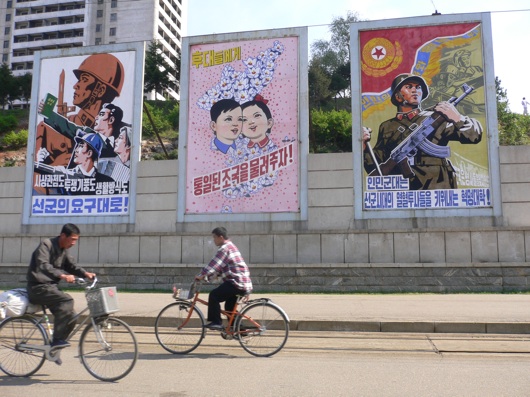 Perhaps somewhat surprisingly, it is a country that values and encourages its artists, however, their creative expression is not their own but that of the now late “Dear Leader”. We visited a studio of artists, all of whom were considered the most skilled and talented in North Korea, and met a woman, Kim Sung Hui, who was painting what was required of her by the regime, but also her own works.
Perhaps somewhat surprisingly, it is a country that values and encourages its artists, however, their creative expression is not their own but that of the now late “Dear Leader”. We visited a studio of artists, all of whom were considered the most skilled and talented in North Korea, and met a woman, Kim Sung Hui, who was painting what was required of her by the regime, but also her own works.
She was tightly controlled, and everything she produced was approved. But her paintings were identifiably her own. In a country so dedicated to eradicating individualism, originality still managed to emerge through the canvases she and the others painted. I am not suggesting that any of the artists were attempting to make any particular statements or stand against the regime. But it made us think that rebellion and insubordination can be found, not just in obvious acts of opposition, but also through the creation of art that reflects one’s own individualism and personality. In the subtle portrayal of life as seen by one person. In incremental changes from what is expected.
All movements in the history of art started like this. And all progression in the rights of women, and indeed humanity generally need to start with one little step, one brush of paint, one small act of creativity.
Joanna Francis spends most of her time hanging out with her one year old son. But she also works for a children’s foundation and has recently started her own little business making baby quilts. Her house is a mess. In the past, Joanna has worked as an aid worker in several developing countries, and is passionate about the rights of women and children. You can visit her and her blog at www.miettehandmade.com
Women in the World: East Timor
I’ve been recently pondering on the role that creativity plays in a country’s cultural identity. Think of the countries you’ve traveled to… Many of them I’m sure, can be associated with a particular type of artistry or craft. Just think of Turkey and their kilims, Japan and woodblock printing, South American ikat weaving…
In many of these examples, these handcrafts are not just an outlet for creative expression (although that is true and important), but are also a way of holding and sharing stories and history. Many countries have little in the way of recorded written history, but have a rich culture of oral histories. And handcrafts and art play a vital role in recording these and allowing them to be shared and passed from one generation to the next.
Take East Timor (Timor-Leste as it is now known and referred to there), one of Australia’s closest neighbours and incongruously, the poorest nation in Asia and the Pacific. Timor Leste is a tiny country with a population of just over 1 million people. It faced oppressive rule until recently, and now is struggling to pull its people out of poverty.
Despite its tiny size, Timor Leste has over 35 languages spoken and fairly rough terrain, making it difficult to have a united recorded history, and making the use of traditional crafts all the more important. One of the most prevalent and important is the weaving of beautiful fabrics called ‘tais’ (pronounced ‘tie-iss’).
Between 2005 and 2007 I lived and worked in its capital Dili, and not surprisingly, I spent many an hour wandering through the markets which sold these beautiful fabrics. I also spent time with women in remote villages who were weaving them and witnessed the important role the weaving played in village life, and how the knowledge contained in its practice was being passed down from the grandmothers to the grandchildren.
I recently asked some questions to Taryn Lane, an Australian woman living in the Southern tip of East Timor and working with the Cooperative for Tais Culture and Sustainable Development (CTKDS).
Taryn writes (after several days of no electricity thanks to major storms!), “Tais weaving is the material expression of a rich living intangible cultural heritage of Timor Leste. Tais is the socio-cultural fabric of life that keeps women connected to their history, stories and ways of being”.
“Many women see weaving as a process of wellbeing and healing after many years of occupation. It is an unbroken thread over eras of rapid change and development. Creativity releases the burden of daily work for the women and connects them to a living heritage of cultural expression”.
“Many Timorese women will learn how to weave from an early age and are immersed in it as it relates to ritual and the cycles of nature. The harvesting of the cotton, the spinning, dyeing and weaving all follow the seasonal patterns of their local area. Each area has its own recipes and processes for the colouring of the cotton and there is a rich intact cultural heritage within East Timor around this".
"Tais are usually necessary for wedding dowries alongside buffalo and to become a weaver is often a rite of passage for many women prior to marriage. Each language group holds their own motifs and stories around the textiles and are a unique expression of who they are”.
The challenge now, for many countries including Timor Leste, is to ensure that these traditions are not lost and that the knowledge and skills are passed on to younger generations. Organisations such as CTKDS are assisting to do this by supporting young women as the next generation of leaders and using community co-operative enterprise models for income generation.
If you are in Australia, you can find out more through ETWA (East Timor Women Australia) and buy or sell the beautiful products that Timorese women make. You can also volunteer, assist in fundraising, take a tour to Timor and if you are really interested, apply for a long term position in Timor Leste!
Further information can be found at www.ctkds.tumblr.com or www.etwa.org.au, or email ctkds.losplaos@gmail.com.au
Joanna Francis spends most of her time hanging out with her one year old son. But she also works for a children’s foundation and has recently started her own little business making baby quilts. Her house is a mess. In the past, Joanna has worked as an aid worker in several developing countries, and is passionate about the rights of women and children. You can visit her and her blog at www.miettehandmade.com
Women in the world: An introduction...
Afghan weaving woman
In East Timor, women gather together and weave colourful blankets called Tais. In London, an artist puts her messy bed on display in an art gallery. In Afghanistan, a woman gathers thrown away drink packets and sews them together to make a shopping bag. In Melbourne, I make quilts.
All over the world, in villages and cities, large scale or small, women are creating. We are creative beings us ladies. Despite hearing regular protestations that “oh but I don’t have a creative bone in my body”, I am a firm believer that all of us have an innate desire to build and make and grow.
Perhaps it is just that as we get older, we have this desire educated out of us (if you haven’t seen Sir Ken Robinson’s TED talk on this, please make yourself a cup of coffee, put your feet up and spend 20 minutes doing yourself a favour.) Or perhaps it is that we are not given the opportunities we need to nurture our creativity, because of poverty, religion, isolation or the fact that we have ten children.
I am fascinated by this topic. Wherever I have traveled around the world, I have been struck by what seems to be a universal desire or need to create. I am fascinated to see the traditions passed down through generations, fascinated by the resourcefulness of women, by the ability to create beauty out of so little and the urge to make some kind of statement through creativity.
So in this little space here over the coming year, I am going to share with you some of these stories. I want to introduce you to some women I have met who have made creativity a big part of their lives, despite facing huge obstacles. We will meet women from Australia who are working with women in other countries to create products and also income and empowerment. We will explore stories from countries as varied as East Timor and North Korea (yes, I did say North).
I also want to explore some of the politics behind creativity in developing countries and pose some questions. For example, do women’s creative enterprises really bring empowerment and positive change? Or do they just add another burden to a woman’s already overwhelming number of roles? And how can we – those of us living in industrialized countries like Australia – actually have some positive impact on the lives of others, either through things we create ourselves, or through the things we buy?
Stay tuned for all this and more! And if you have ideas you’d like to explore or learn more about, or stories you'd like to share, I'd love to hear from you.
Joanna Francis spends most of her time hanging out with her one year old son. But she also works for a children’s foundation and has recently started her own little business making baby quilts. Her house is a mess. In the past, Joanna has worked as an aid worker in several developing countries, and is passionate about the rights of women and children. You can visit her and her blog at www.miettehandmade.com

